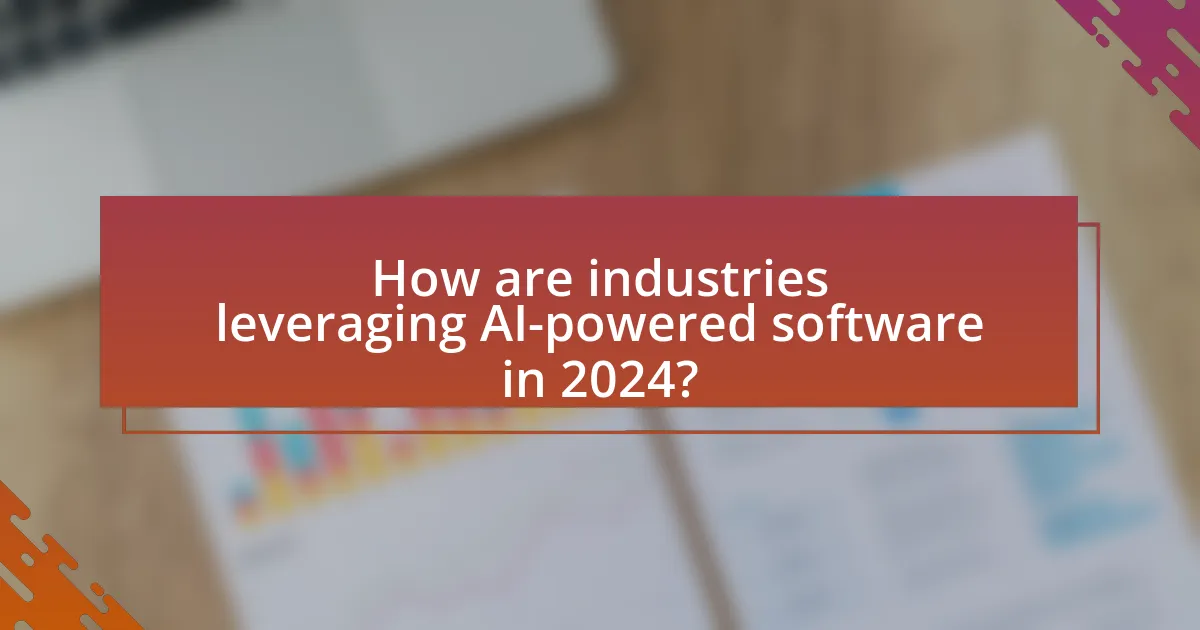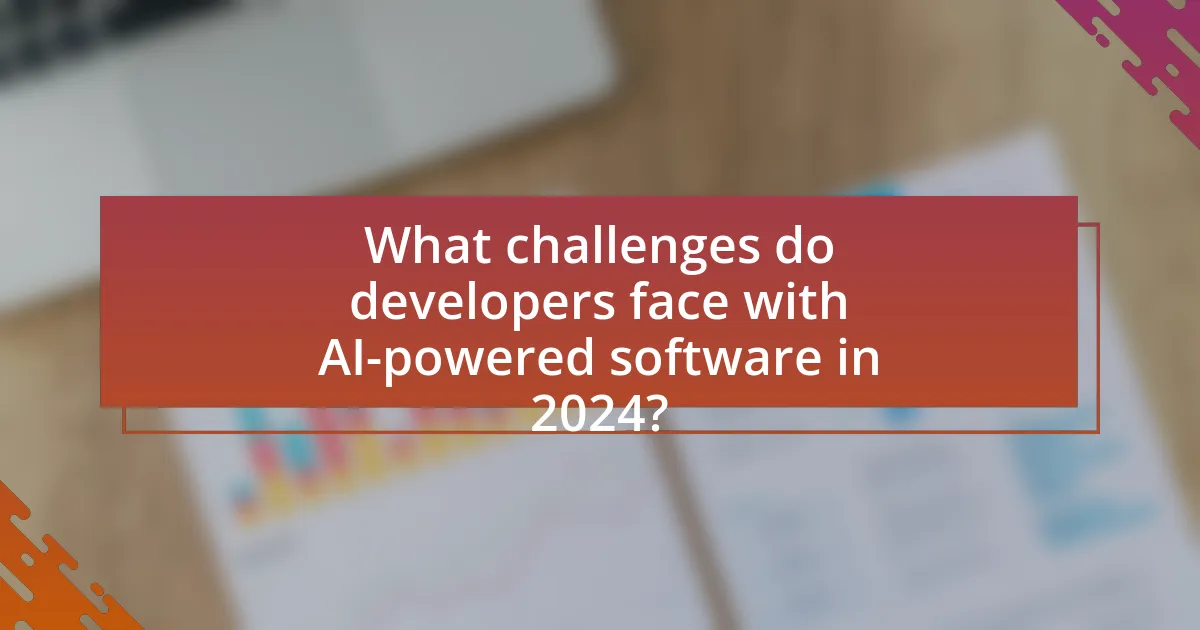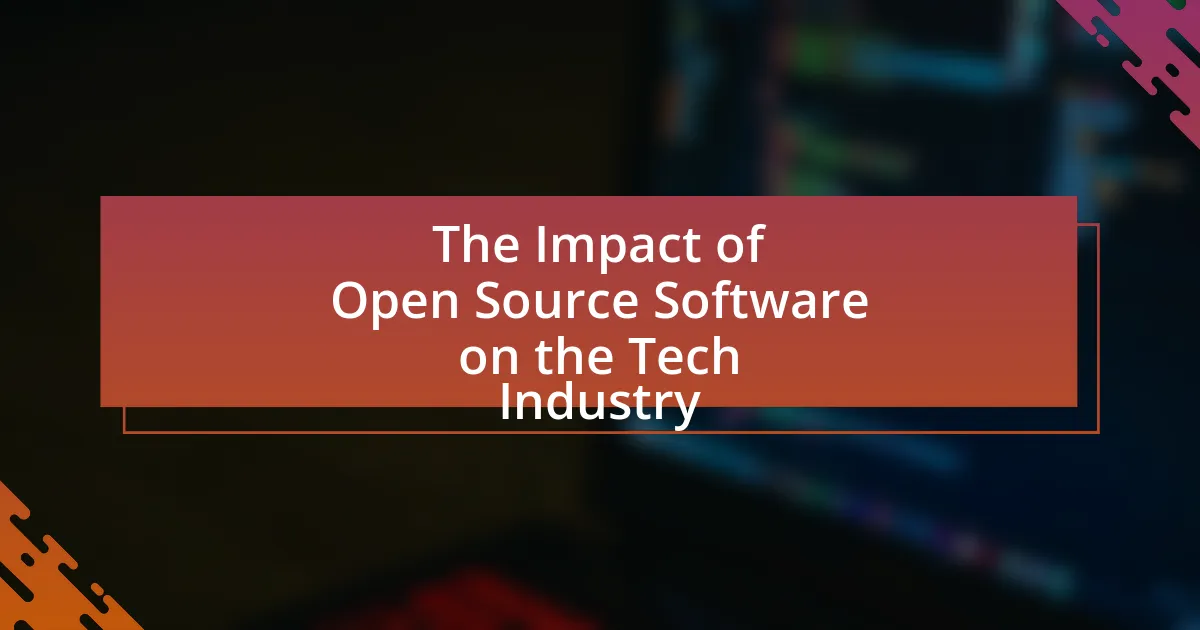The article focuses on the future of AI-powered software, highlighting key trends expected to shape the landscape in 2024. It discusses the integration of generative AI, enhanced personalization through machine learning, and the growing emphasis on ethical AI practices. The piece also examines the evolution of AI in software development, the impact of new technologies, and the adaptation of development methodologies. Additionally, it addresses user experience, changing user expectations, and emerging design principles for AI interfaces. The article further explores the ethical considerations in AI development, industry applications, and the challenges developers face, providing a comprehensive overview of the current and future state of AI software.

What are the key trends shaping the future of AI-powered software in 2024?
Key trends shaping the future of AI-powered software in 2024 include increased integration of generative AI, enhanced personalization through machine learning, and a focus on ethical AI practices. Generative AI is expected to revolutionize content creation and automation, with tools like ChatGPT and DALL-E leading the way in generating text and images. Enhanced personalization will leverage advanced algorithms to tailor user experiences, improving engagement and satisfaction. Additionally, ethical AI practices will gain prominence as organizations prioritize transparency and accountability, driven by regulatory pressures and public demand for responsible AI usage. These trends reflect the evolving landscape of AI technology and its applications across various industries.
How is AI integration evolving in software development?
AI integration in software development is evolving through increased automation, enhanced collaboration, and improved decision-making capabilities. Automation tools powered by AI, such as code generation and testing frameworks, are streamlining repetitive tasks, allowing developers to focus on more complex problems. Collaborative platforms are leveraging AI to facilitate communication and project management, improving team efficiency. Additionally, AI-driven analytics are providing insights that help developers make data-informed decisions, optimizing the software development lifecycle. According to a report by Gartner, by 2025, 70% of new applications developed by enterprises will use AI, highlighting the significant shift towards AI-enhanced development practices.
What new technologies are driving AI integration?
New technologies driving AI integration include advanced machine learning algorithms, natural language processing, and edge computing. Advanced machine learning algorithms enhance AI’s ability to analyze vast datasets, improving decision-making and predictive capabilities. Natural language processing enables more intuitive human-computer interactions, allowing AI systems to understand and respond to human language effectively. Edge computing facilitates real-time data processing closer to the source, reducing latency and improving the efficiency of AI applications. These technologies collectively enhance AI’s functionality and accessibility across various sectors, including healthcare, finance, and customer service.
How are development methodologies adapting to AI advancements?
Development methodologies are adapting to AI advancements by integrating AI tools and practices into their frameworks, enhancing efficiency and decision-making. Agile methodologies, for instance, are increasingly incorporating AI-driven analytics to optimize sprint planning and backlog prioritization, allowing teams to respond more dynamically to changing requirements. Additionally, DevOps practices are evolving to include AI for continuous integration and deployment, automating testing and monitoring processes, which reduces time-to-market and improves software quality. These adaptations are supported by industry reports indicating that organizations leveraging AI in their development processes experience up to 30% faster delivery times and improved project outcomes.
What role does user experience play in AI-powered software?
User experience is crucial in AI-powered software as it directly influences user satisfaction and engagement. A well-designed user experience ensures that AI functionalities are intuitive and accessible, allowing users to effectively interact with complex algorithms. Research indicates that 70% of users abandon applications due to poor usability, highlighting the importance of user-centered design in enhancing the effectiveness of AI solutions. By prioritizing user experience, developers can create software that not only meets user needs but also fosters trust and encourages continued use, ultimately driving the success of AI applications in various sectors.
How are user expectations changing with AI capabilities?
User expectations are evolving to demand more personalized, efficient, and intuitive interactions with AI systems. As AI capabilities advance, users increasingly expect these systems to understand context, anticipate needs, and provide tailored solutions. For instance, a survey by McKinsey in 2022 indicated that 70% of consumers prefer personalized experiences, highlighting the shift towards expecting AI to deliver customized content and recommendations. This trend reflects a broader desire for seamless integration of AI into daily tasks, where users anticipate not just functionality but also a user-friendly experience that enhances productivity and satisfaction.
What design principles are emerging for AI-driven interfaces?
Emerging design principles for AI-driven interfaces include user-centricity, transparency, and adaptability. User-centricity emphasizes designing interfaces that prioritize user needs and experiences, ensuring that interactions are intuitive and accessible. Transparency involves making AI processes understandable to users, allowing them to grasp how decisions are made, which builds trust. Adaptability refers to the ability of interfaces to learn from user behavior and preferences, personalizing experiences over time. These principles are supported by research indicating that user satisfaction increases when interfaces are designed with these factors in mind, as highlighted in studies on human-computer interaction.
What ethical considerations are influencing AI software development?
Ethical considerations influencing AI software development include fairness, accountability, transparency, and privacy. Fairness ensures that AI systems do not perpetuate biases, as evidenced by studies showing that biased training data can lead to discriminatory outcomes in algorithms. Accountability involves establishing clear responsibility for AI decisions, highlighted by regulatory frameworks like the EU’s AI Act, which mandates that developers ensure their systems are safe and ethical. Transparency requires that AI processes are understandable to users, supported by initiatives advocating for explainable AI to foster trust. Privacy concerns arise from the collection and use of personal data, with regulations such as GDPR emphasizing the need for data protection in AI applications.
How are companies addressing bias in AI algorithms?
Companies are addressing bias in AI algorithms by implementing diverse data sets, conducting regular audits, and employing fairness-enhancing interventions. For instance, organizations like Google and IBM have developed tools such as What-If Tool and AI Fairness 360, respectively, which allow for the evaluation of model performance across different demographic groups. Additionally, companies are increasingly adopting guidelines and frameworks, such as the IEEE’s Ethically Aligned Design, to ensure ethical considerations are integrated into the AI development process. These measures are supported by research indicating that diverse training data can significantly reduce bias, as highlighted in studies published by the Partnership on AI.
What regulations are being implemented to govern AI use?
Regulations being implemented to govern AI use include the European Union’s Artificial Intelligence Act, which aims to establish a legal framework for AI technologies by categorizing them based on risk levels and imposing requirements for transparency and accountability. This act is part of a broader effort to ensure ethical AI deployment, protect fundamental rights, and promote innovation within the EU. Additionally, various countries are developing their own guidelines and frameworks, such as the United States’ National AI Initiative, which focuses on fostering AI research while addressing safety and ethical concerns. These regulations are designed to mitigate risks associated with AI, such as bias and privacy violations, thereby ensuring responsible use of AI technologies.

How are industries leveraging AI-powered software in 2024?
Industries are leveraging AI-powered software in 2024 to enhance operational efficiency, improve customer experiences, and drive innovation. For instance, the healthcare sector utilizes AI for predictive analytics, enabling early diagnosis and personalized treatment plans, which has been shown to reduce patient readmission rates by up to 20%. In retail, companies implement AI-driven inventory management systems that optimize stock levels and reduce waste, leading to a reported 15% increase in profit margins. Additionally, the financial industry employs AI algorithms for fraud detection, significantly decreasing fraudulent transactions by over 30%. These applications demonstrate how AI-powered software is transforming various sectors by providing data-driven insights and automating complex processes.
Which sectors are seeing the most significant impact from AI software?
The sectors seeing the most significant impact from AI software include healthcare, finance, retail, and manufacturing. In healthcare, AI enhances diagnostics and personalized treatment, evidenced by a study from the Journal of Medical Internet Research showing AI’s accuracy in detecting diseases. In finance, AI algorithms improve fraud detection and risk assessment, with a report from McKinsey indicating that AI could generate up to $1 trillion in value annually for the banking sector. Retail benefits from AI through personalized shopping experiences and inventory management, as highlighted by a Deloitte study showing a 10-30% increase in sales for AI-implemented retailers. Lastly, manufacturing utilizes AI for predictive maintenance and supply chain optimization, with a report from PwC estimating that AI could contribute $15.7 trillion to the global economy by 2030, significantly impacting this sector.
How is AI transforming healthcare software solutions?
AI is transforming healthcare software solutions by enhancing diagnostic accuracy, streamlining administrative processes, and personalizing patient care. For instance, AI algorithms analyze medical images with up to 94% accuracy, significantly improving early detection of conditions like cancer. Additionally, AI-driven chatbots and virtual assistants reduce administrative burdens by automating appointment scheduling and patient inquiries, leading to a 30% decrease in operational costs for healthcare providers. Furthermore, AI systems leverage patient data to create tailored treatment plans, resulting in improved patient outcomes and satisfaction. These advancements demonstrate AI’s critical role in revolutionizing healthcare software solutions.
What advancements are being made in AI for financial services?
Advancements in AI for financial services include enhanced fraud detection, personalized customer experiences, and improved risk assessment. Financial institutions are increasingly utilizing machine learning algorithms to analyze transaction patterns, which allows for real-time identification of fraudulent activities, significantly reducing losses; for instance, a report by McKinsey indicates that AI can reduce fraud-related losses by up to 50%. Additionally, AI-driven chatbots and virtual assistants are being deployed to provide tailored financial advice and support, improving customer engagement and satisfaction. Furthermore, AI models are being developed to assess credit risk more accurately by analyzing a broader range of data points, leading to better lending decisions and reduced default rates.
What are the emerging use cases for AI-powered software?
Emerging use cases for AI-powered software include personalized healthcare, automated customer service, and predictive analytics in various industries. In personalized healthcare, AI algorithms analyze patient data to tailor treatment plans, improving outcomes and efficiency. Automated customer service utilizes AI chatbots to handle inquiries, reducing response times and operational costs. Predictive analytics leverages AI to forecast trends and behaviors, enabling businesses to make data-driven decisions. These applications are supported by advancements in machine learning and natural language processing, which enhance the capabilities and effectiveness of AI systems across sectors.
How is AI enhancing customer service applications?
AI is enhancing customer service applications by automating responses and personalizing interactions. This automation allows businesses to handle a higher volume of inquiries efficiently, reducing wait times and improving customer satisfaction. For instance, AI chatbots can provide instant answers to frequently asked questions, which has been shown to decrease response times by up to 80%. Additionally, AI analyzes customer data to tailor responses and recommendations, leading to a more personalized experience. Research from McKinsey indicates that companies using AI in customer service can improve customer satisfaction scores by 10-20%.
What innovative applications are being developed in education through AI?
Innovative applications being developed in education through AI include personalized learning platforms, intelligent tutoring systems, and automated administrative tasks. Personalized learning platforms utilize AI algorithms to tailor educational content to individual student needs, enhancing engagement and effectiveness. Intelligent tutoring systems provide real-time feedback and support, adapting to student performance to improve learning outcomes. Additionally, AI is streamlining administrative tasks such as grading and scheduling, allowing educators to focus more on teaching. These advancements are supported by research indicating that AI can significantly enhance educational efficiency and student performance, as seen in studies published by the International Society for Technology in Education.
How are businesses measuring the success of AI-powered software?
Businesses are measuring the success of AI-powered software primarily through key performance indicators (KPIs) such as return on investment (ROI), user engagement metrics, and operational efficiency improvements. For instance, a study by McKinsey found that organizations implementing AI technologies reported a 20% increase in productivity and a 30% reduction in operational costs, demonstrating tangible benefits. Additionally, businesses often assess customer satisfaction scores and the accuracy of AI predictions to evaluate effectiveness, with a report from Deloitte indicating that 62% of companies use customer feedback as a critical metric for AI success.
What metrics are most effective for evaluating AI software performance?
The most effective metrics for evaluating AI software performance include accuracy, precision, recall, F1 score, and area under the ROC curve (AUC-ROC). Accuracy measures the overall correctness of the model’s predictions, while precision indicates the proportion of true positive results among all positive predictions, highlighting the model’s reliability. Recall assesses the model’s ability to identify all relevant instances, and the F1 score provides a balance between precision and recall, making it useful for imbalanced datasets. AUC-ROC evaluates the model’s ability to distinguish between classes across various threshold settings, providing insight into its performance across different scenarios. These metrics are widely recognized in the field of machine learning and are essential for a comprehensive evaluation of AI software effectiveness.
How can companies assess ROI from AI investments?
Companies can assess ROI from AI investments by measuring the financial impact of AI initiatives against their costs. This involves quantifying benefits such as increased revenue, cost savings, and efficiency improvements directly attributable to AI applications. For instance, a study by McKinsey found that organizations implementing AI can achieve a 20-30% increase in productivity, which can be translated into financial gains. Additionally, companies should track key performance indicators (KPIs) relevant to their specific AI projects, such as customer satisfaction scores or operational efficiency metrics, to provide a clearer picture of the investment’s effectiveness. By comparing these metrics against the initial investment and ongoing operational costs, businesses can derive a comprehensive understanding of their ROI from AI investments.

What challenges do developers face with AI-powered software in 2024?
Developers face several challenges with AI-powered software in 2024, including data privacy concerns, algorithmic bias, and integration complexities. Data privacy is critical as regulations like GDPR require strict compliance, making it difficult for developers to manage user data responsibly. Algorithmic bias poses a risk as AI systems can inadvertently perpetuate existing biases in training data, leading to unfair outcomes. Additionally, integration complexities arise when incorporating AI into existing systems, requiring significant adjustments and expertise. These challenges necessitate ongoing education and adaptation within the development community to ensure ethical and effective AI deployment.
What technical hurdles are present in AI software development?
Technical hurdles in AI software development include data quality issues, algorithmic bias, and computational resource limitations. Data quality is crucial, as poor or unrepresentative data can lead to inaccurate models; for instance, a study by the Stanford University AI Lab found that biased training data can result in discriminatory outcomes in AI applications. Algorithmic bias arises when AI systems reflect societal biases present in the training data, which can perpetuate inequality and lead to ethical concerns. Additionally, computational resource limitations, such as insufficient processing power and memory, can hinder the training of complex models, as evidenced by the increasing demand for GPUs in AI research, which has surged by over 300% in recent years. These hurdles collectively challenge the effectiveness and fairness of AI software development.
How do data quality and availability affect AI outcomes?
Data quality and availability significantly influence AI outcomes by determining the accuracy and reliability of the models developed. High-quality data, characterized by completeness, consistency, and relevance, enables AI systems to learn effectively, leading to better predictions and decision-making. Conversely, poor data quality can result in biased or erroneous outputs, undermining the trustworthiness of AI applications. For instance, a study by the MIT Sloan Management Review found that organizations with high data quality reported a 20% increase in AI project success rates compared to those with low data quality. Additionally, the availability of diverse datasets enhances the model’s ability to generalize across different scenarios, further improving performance. Thus, both data quality and availability are critical for achieving optimal AI outcomes.
What are the challenges of maintaining AI systems post-deployment?
Maintaining AI systems post-deployment presents several challenges, including model drift, data quality issues, and resource allocation. Model drift occurs when the performance of an AI model degrades over time due to changes in the underlying data distribution, necessitating regular updates and retraining to ensure accuracy. Data quality issues arise when the input data becomes outdated or inconsistent, which can lead to erroneous outputs and decreased reliability of the AI system. Additionally, resource allocation challenges involve the need for ongoing computational resources and skilled personnel to monitor, maintain, and improve the AI systems, which can strain organizational budgets and capabilities. These challenges highlight the importance of implementing robust maintenance strategies to ensure the long-term effectiveness of AI technologies.
How are organizations addressing the skills gap in AI development?
Organizations are addressing the skills gap in AI development by implementing targeted training programs and partnerships with educational institutions. For instance, companies like Google and Microsoft have launched initiatives such as AI-focused boot camps and online courses to enhance the skill sets of their workforce. Additionally, collaborations with universities for research and curriculum development ensure that emerging talent is equipped with relevant AI competencies. According to a report by McKinsey, 87% of companies are experiencing a skills gap in AI, prompting them to invest in upskilling and reskilling efforts to meet the growing demand for AI expertise.
What training programs are emerging for AI skill development?
Emerging training programs for AI skill development include online courses, bootcamps, and university partnerships focused on machine learning, data science, and AI ethics. Notable examples are Coursera’s AI for Everyone, Udacity’s AI Nanodegree, and Google’s AI Education initiative, which aim to equip learners with practical skills and theoretical knowledge. These programs are designed to meet the growing demand for AI expertise in various industries, as evidenced by a report from the World Economic Forum indicating that 85 million jobs may be displaced by automation by 2025, highlighting the need for reskilling in AI technologies.
How can companies foster a culture of continuous learning in AI?
Companies can foster a culture of continuous learning in AI by implementing structured training programs and encouraging knowledge sharing among employees. Structured training programs, such as workshops and online courses, provide employees with the necessary skills to stay updated with AI advancements. Encouraging knowledge sharing through regular team meetings and collaborative projects allows employees to learn from each other’s experiences and insights. Research by McKinsey indicates that organizations that prioritize continuous learning can improve their productivity by up to 30%. By investing in these initiatives, companies can create an environment that promotes ongoing education and adaptation to new AI technologies.
What best practices can ensure successful AI software implementation?
Successful AI software implementation requires a clear strategy, stakeholder engagement, and continuous evaluation. Establishing a well-defined strategy ensures alignment with business objectives, while engaging stakeholders fosters collaboration and buy-in, which are critical for adoption. Continuous evaluation through metrics and feedback loops allows for adjustments and improvements, ensuring the AI solution remains effective and relevant. According to a McKinsey report, organizations that prioritize these practices are 1.5 times more likely to achieve successful AI outcomes, highlighting the importance of structured approaches in AI implementation.
How can teams effectively collaborate on AI projects?
Teams can effectively collaborate on AI projects by establishing clear communication channels, defining roles and responsibilities, and utilizing collaborative tools. Clear communication ensures that all team members are aligned on project goals and progress, which is crucial in complex AI environments where tasks often overlap. Defining roles helps to leverage individual strengths, allowing team members to focus on their areas of expertise, such as data science, engineering, or project management. Utilizing collaborative tools like version control systems, project management software, and shared coding environments facilitates real-time collaboration and tracking of changes, which is essential for maintaining project momentum. Research indicates that teams employing structured collaboration frameworks can improve project outcomes by up to 30%, highlighting the importance of these practices in AI project success.
What strategies can mitigate risks associated with AI deployment?
Implementing robust governance frameworks is a key strategy to mitigate risks associated with AI deployment. These frameworks should include clear policies on data usage, ethical guidelines, and accountability measures to ensure compliance with regulations. For instance, organizations can adopt the AI Ethics Guidelines set forth by the European Commission, which emphasize transparency, fairness, and accountability in AI systems. Additionally, conducting regular risk assessments and audits can help identify potential vulnerabilities and ensure that AI systems operate within acceptable risk thresholds. Research indicates that companies with established governance frameworks experience 30% fewer incidents related to AI failures, highlighting the effectiveness of these strategies in risk mitigation.




